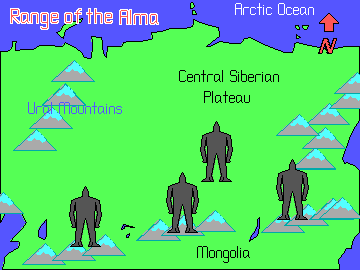The
"Wild Man" of Central Asia
|

Artist's
sketch of the "Alma"
|
In central Asia, in what, until a few years ago
was the Soviet Union, there are stories of a large, ape-like
creature that inhabits the mountains. It goes by the name of
the Alma.
Unlike the better known Bigfoot and Yeti, reports
about the Alma say that the creature is much more of a rough,
hairy human than an ape. Professor Boris Porchnev, of
the Moscow Academy of Sciences, published a description of the
creature based on detailed stories he'd gathered from people
who had seen it.
"There is no underlayer of hair so that the skin
can sometimes be seen," says the report. "The head rises to
a cone-shaped peak," it continues, and "the teeth are like a
man's, but larger, with the canines more widely separated."
Porchnev's description also noted that the Alma can run as fast
as a horse and swim in swift currents. Breeding pairs remain
together living in holes in the ground. For food they eat small
animals and vegetables. The creatures are mainly active at night.
The report also noted that the animals have a "distasteful smell."
The first stories of the Alma were gathered in
1881 by N. M. Pzewalski, a traveler in Mongolia who also discovered
the Mongolian wild horse. During the Second World War refugees,
soldiers, and prisoners of war, often reported seeing the Alma.
Slavomir Rawicz, in his book The Long Walk, the story
of his escape from a Siberian labor camp, tells of being delayed
by a pair of Almas. Chinese soldiers reportedly put food out
for the Alma and watched it eat.
M.A. Stonin, a geologist, was prospecting near
Tien Shan in 1948. One morning he awoke to cries by his guides
that the horses were being stolen. Stonin grabbed his rifle
and headed outside to find a figure standing by the horses.
It had long red-hair all over it's body. The creature moved
off at Stonin's shouts and he chased after it. The animal was
so man-like, though, that Stonin couldn't bring himself to shoot
it and the thing escaped.
In 1957 a hydrologist named Alexander G. Pronin,
on an expedition to study water resources, reported seeing "a
being of unusual aspect." It stood at a distance in the snow
with it's legs wide apart and with arms longer than a normal
man's. Pronin watched it for five minutes, then the creature
disappeared behind a rock. Three days later he saw the figure
again briefly. Then a week later one of the group's inflatable
boats disappeared without explanation and was later found upstream.
Pronin found out that the locals often blamed the "wild man"
with stealing household items and taking them into the mountains.
This made Pronin wonder if the Alma was responsible for the
missing boat.
Alma's have reportedly been shot and killed, but
the carcasses have never been examined by scientists. In 1937,
during a clash with the Japanese, a Russian reconnaissance unit
in Mongolia spotted two silhouettes coming down a hill toward
them. When the figures did not respond to a challenge, sentries
shot them. Then next morning the recon unit was surprised when
they examined the bodies. They were of a "strange anthropoid
ape" that was about the size of a man and covered with long
red hair. Unfortunately, because of the war, the bodies could
not be returned to Moscow for a proper evaluation.
 While
the Soviet Union was still together several expeditions were
mounted to look for the Alma. While they gathered some interesting
stories, and a few unusual artifacts, no Alma was ever captured
and Soviet scientists became split over the value of searching
for it. Dr. Proshnev took quite a ribbing from his colleagues
because of his work on the subject.
While
the Soviet Union was still together several expeditions were
mounted to look for the Alma. While they gathered some interesting
stories, and a few unusual artifacts, no Alma was ever captured
and Soviet scientists became split over the value of searching
for it. Dr. Proshnev took quite a ribbing from his colleagues
because of his work on the subject.
Proshnev speculated that the creature is perhaps
the last surviving group of Neanderthal men. At least a few
western researchers, including Dr. Myra Shackely, of
Leicester University in England, agree with him. Shackely, who
visited Mongolia in 1979, points out that the entire area is
loaded with Neanderthal artifacts. She notes that if Neanderthal
were to have survived it would most likely have been in those
areas were the Alma is reported.
Since the dismemberment of the Soviet Union little
has been done to continue research on the Alma. Those regions
were it has been reported are often politically unstable, and
economic conditions in Russia, who inherited many of the scientific
institutions of the old Soviet Union, have not been favorable
to allowing continued research on the "Wild Man."

Copyright Lee Krystek 1996.
All rights Reserved.